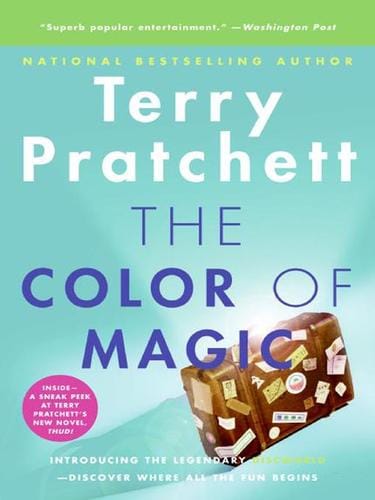Exploring “The Color of Magic”: Terry Pratchett’s Discworld Debut
Discover the humor, plot, and impact of Terry Pratchett’s The Color of Magic in this detailed, spoiler-free guide to Discworld’s first adventure.

Introduction to The Color of Magic
Published in 1983, Terry Pratchett’s The Color of Magic is the comedic cornerstone that launched the sprawling, best-selling Discworld series. Part parody, part homage to classic sword-and-sorcery fiction, the novel whisks readers onto a flat planet balanced on the backs of four elephants who themselves stand on a gigantic cosmic turtle. The bizarre visual immediately signals that this is no ordinary fantasy adventure; it is a place where logic bends, tropes are gleefully lampooned, and satire shares equal billing with high-stakes escapades.
Terry Pratchett and the Birth of Discworld
Before Discworld, Terry Pratchett was already a journalist and author, yet he had not found the signature tone that would make him a global phenomenon. With The Color of Magic, Pratchett discovered a voice that blended razor-sharp wit with genuine affection for the genre he poked fun at. The book’s success encouraged him to expand Discworld into a 41-novel saga, each installment dissecting everything from Hollywood to organized religion while remaining accessible to new readers. In retrospect, this first novel feels rawer than later entries, but its imaginative energy remains infectious.
Plot Overview Without Spoilers
The story begins in Ankh-Morpork, Discworld’s largest and least reputable city, where a failed wizard named Rincewind becomes reluctant tour guide to Twoflower, the planet’s first tourist. Twoflower hails from the distant and wealthy Agatean Empire, armed with boundless optimism, an experimental camera called an iconograph, and a magical, sapient traveling trunk known simply as the Luggage. Through a series of increasingly explosive misunderstandings, the duo flee assassins, crash a dragon-rider society, and nearly tumble off the edge of the world, all while cosmic deities wager on their survival. The episodic structure deliberately mirrors the short-story collections of classic pulp fantasy, yet Pratchett imbues each vignette with comic timing that keeps pages turning.
Main Characters: Rincewind, Twoflower, and The Luggage
Rincewind is the consummate anti-hero: cowardly, self-serving, and famously inept at spells, largely because an experimental magic word fused itself in his brain during a college mishap. Despite—or perhaps because of—his incompetence, readers find him immensely relatable; he is the voice of reason screaming against a world gone mad. Twoflower, by contrast, is naively enthusiastic, choosing to see wonder where others see danger. His stubborn optimism forms the novel’s emotional core, challenging Rincewind’s gloomy outlook. Meanwhile, the Luggage scuttles along on dozens of tiny legs, devouring would-be thieves and faithfully reuniting with its owner. Acting almost like a silent third lead, it embodies the unpredictable magic of Discworld.
World-Building and Satire
Pratchett’s world-building shines not because of encyclopedic lore but because of incisive cultural commentary. Wizards operate less like mystical sages and more like squabbling academics vying for tenure. The city watch is corrupt, guilds regulate everything from thievery to assassinations, and even dragons exist as figments of collective imagination—literally sustained by belief. These clever inversions allow Pratchett to lampoon real-world institutions while acknowledging their absurdity. The result is a universe that feels lived-in yet mercurial, where rules exist only to be hilariously broken.
Why The Color of Magic Still Matters
Four decades on, The Color of Magic remains essential reading for fantasy fans and newcomers alike. Its playful dismantling of genre clichés paved the way for modern comedic fantasy authors like Jasper Fforde and Douglas Adams aficionados crossing into sword-and-sorcery territory. Moreover, the novel introduces themes—power, belief, narrative itself—that Pratchett would later explore with profound depth. Rereading today reveals layers of social observation that resonate amid contemporary conversations about authority, tourism, and the stories cultures tell about themselves.
Reading Tips for Newcomers
Some readers find the book’s episodic pace and rapid shifts of setting disorienting, especially if they begin with later, more polished Discworld titles. To maximize enjoyment, treat the novel as a collection of connected adventures rather than a tightly plotted epic. Allow the humor to wash over you and notice the seeds of bigger ideas that Pratchett will revisit in sequels. If possible, choose an edition that includes the author’s foreword or maps; these extras provide context and illuminate in-jokes.
Start With the Right Edition
Modern reprints often feature updated cover art, footnotes, and even appendices. Audiobook fans will appreciate Nigel Planer’s spirited narration, which captures Rincewind’s perpetual panic and Twoflower’s childlike awe. Whichever format you pick, keep a notepad or e-reader bookmark handy for quotes—Pratchett’s one-liners beg to be shared.
Where to Go After The Color of Magic
If you finish yearning for more, the immediate sequel The Light Fantastic wraps up Rincewind’s early storyline. After that, consider moving to Mort or Guards! Guards!, books that start distinct sub-series focusing on Death and the City Watch respectively. Each entry stands alone while contributing to a grand mosaic, so feel free to follow characters or concepts that intrigue you. Just remember: Discworld does not demand strict chronological reading, an approach as liberating as the series’ off-kilter physics.
Final Thoughts
The Color of Magic may not be Pratchett’s most sophisticated novel, yet it sparkles with inventive gags, memorable set pieces, and the promise of a universe where humor and heart coexist. Whether you’re a long-time fantasy veteran tired of predictable tropes or a curious reader hunting for your next literary obsession, Discworld’s inaugural voyage offers 800 words’ worth of proof that satire and sorcery are natural companions. Step aboard the turtle’s back; adventure—and laughter—await.



